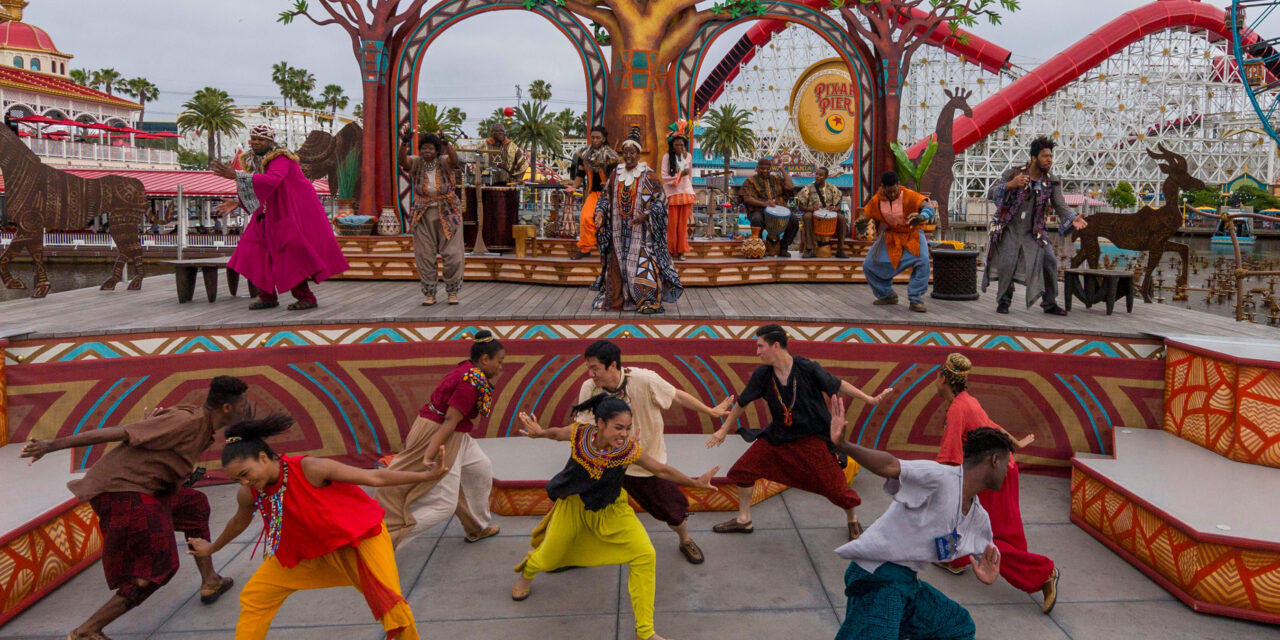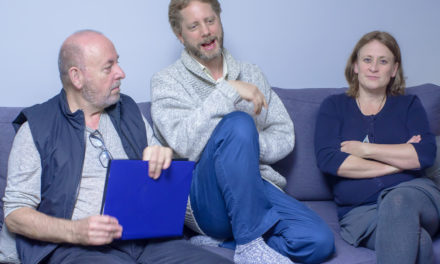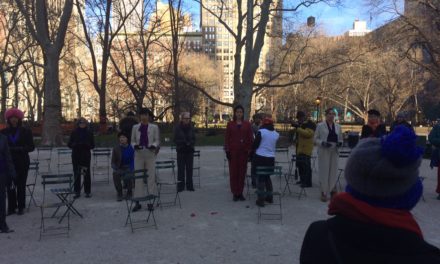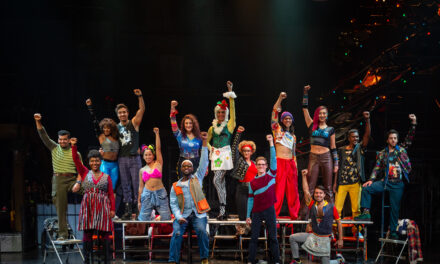Visitors to Disney California Adventure Park should be sure to check their schedules and make time for Tale of the Lion King, a new adaptation of the beloved story with a cast of 18 performers in an ensemble that works together as a group known as “Storytellers of the Pride Lands.” Creative Director Susana Tubert and the team at Disney Parks Live Entertainment have brought together artists, designers, researchers, cultural experts, performers and more to craft an outdoor musical production that features new arrangements of songs that are simply hard to beat in the realm of musical theatre – and that was before they transformed them into the harmonious delight you will experience here. Driven by the idea that this troupe of storytellers is passing on an oral tradition, the show is able to tap into emotional pools that first started to gather when human beings sat to listen to shamans and tribal leaders when they shared tales of triumph, loss, and love – long before we could have begun to dream of anything so glorious as an animated feature film.
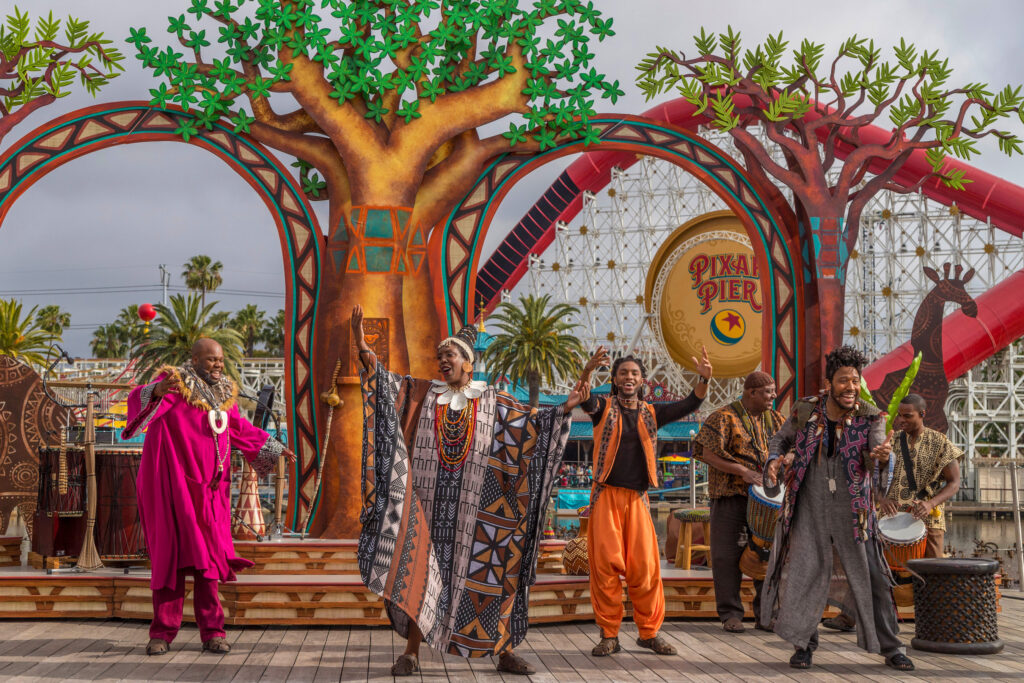
“Tale of the Lion King” at Disney California. Photo credit: Joshua Sudock/Disneyland Resort.
The lead narrator, Mwongozo (Swahili for “guide”) launches us into the story and is the one that keeps the narrative moving forward but every performer in the show is a storyteller, rotating in to take on the role of Simba or Mufasa or Nala or Scar then stepping out of the narrative to lend their voice as a singer when their role in the story is not central. These men and women tell us a tale that has been handed down from generation to generation but, as they note, ‘each time someone tells it, the tale becomes a bit their own.’ Just as the song “Circle of Life” tells us, the circle of life moves us all ’till we find our place on the path unwinding,’ this story of tragedy, despair, love, hope, courage, and justice has found its place in our modern mythology and its success in finding an intractable place in our hearts and minds may well be related to the fact that we are all able to make it our own. Let us not forget that this was the first Disney animated feature that was an original story – no less one that illustrated the death of a father and the impact it has on his son. We have all experienced some kind of loss that has transformed us. The Lion King reminds us that the loss does not have to define us forever; it can, instead, connect us, unite us, and make us whole. Live entertainment in the park is a beautiful addition that should be encouraged on all fronts. It really brings the stories to life in a new way that will allow people to re-experience and fall in love with them all over again.
I was able to speak with Susana Tubert about this piece, the efforts and thoughtful creative impulses behind it and how her vast experience as a theatre artist has merged with her role at Disney overall.
I’m wondering about you Susana, your past experience and your role as Creative Director at Disney.
I was a theatre director in New York, and very much a part of the local and national theatre scene from 1980 until I relocated to California in 2013. My last project there prepared me for my current role as Creative Director at the Disneyland Resort. In 2005 I co-founded the organization Latino International Theater Festival of New York and two years later we premiered the inaugural TeatroStageFest. Our mission was to showcase Great Theater for All Audiences! As its Executive Director, I curated and produced eight seasons of a two-week festival that featured theatre, music and dance productions from Spain, the Caribbean, and Latin America, side by side with local companies. We also held free master classes, artist panels, TeatroStageFamily puppetry shows for kids, and playwriting workshops for high school students. We made ticketing accessible to families in underserved communities, while also reaching the cosmopolitan culture seekers of New York who are not necessarily Latinos – but love to experience wonderful global theatre. We took great pride in becoming an Official Event of the City of New York and produced two international tours to South America as well as a four-city national tour. In 2013 as we drew the final curtain on TeatroStageFest, I applied for this opportunity at The Walt Disney Company and was selected out of three hundred candidates to come and work here. I like to say that I went from the Big Apple to the Happiest Place on Earth!
From what you just told me, going to the source of culture that some of us may not encounter day-to-day and bringing that source to light in a theatrical environment where it can be entertaining and educational and just a whole different thing than you might expect…
Yes, and when you find yourself at the right time and at the right place, anything is possible, no? In my case, I learned that it’s not just Disney Parks that is currently encouraging diversity; in fact, the entire Walt Disney Company is expanding its repertoire of narratives. In the last few years, we’ve seen live action films like Black Panther, animated features like Moana and Coco … even Princess Elena on The Disney Channel, to name a few. There is just so much great storytelling that allows me to do what I do so well, which is to provide a cultural perspective that’s extremely specific and extremely universal. I refer to it as being “culturally authentic, and uniquely Disney.” In 2013, the first project I oversaw the development of was a festive holiday show that is still running at Disney California Adventure Park today called Disney ¡Viva Navidad! It’s a celebration of Christmas from a Latin American perspective that’s hosted by the Three Caballeros – Panchito from Mexico, José Carioca from Brazil and Donald Duck as Everyman – or “Everyduck,” who loves to learn about his friends’ culture through their shared love of music and dance. Mickey and Minnie join the party, along with huge mojiganga puppets inspired by Mexican folk art, and authentic Mexican Folklórico and Brazilian Samba dancers, Mariachis and Brazilian percussionists. The show’s success paved the way for Disney Parks Live Entertainment to build on the park’s beautiful tapestry of diversity. The seasonal “Disney Festival of Holidays” celebrates Christmas, Navidad, Hanukkah, Diwali, Kwanzaa and The Three Kings, while Mulan’s Lunar New Year Celebration speaks to Chinese, Korean and Vietnamese traditions. At our seasonal Plaza de la Familia, Miguel’s journey in the film Coco allows us to celebrate the spirit of Día de los Muertos (Day of the Dead.) And now, our most current offering, Tale of the Lion King, builds upon these rich and beautiful cultural stories at the heart of The Walt Disney Company.
What other projects have you overseen at the Park?
One of the most thrilling projects was developing the fireworks and multi-media production Together Forever – A Pixar Nighttime Spectacular at Disneyland Park in 2018. I had never worked on a spectacular; how fun is that? It was like composing a symphony – a multi-media symphony – in collaboration with an incredible team of Disney artists. What was most exciting to me, given my theater background, was to challenge ourselves to develop a show that was built on a dramaturgical structure, with a beginning, a middle and an end. I didn’t want to just celebrate random friendships by piling on more and more segments. I wanted the structure of the show to have an emotional arc and an emotional pay-off in the end. It was important to earn that final heart-tugging celebration of Pixar friendships! To that end, the symphony was made up of an “overturette,” three movements and a finale. In the opening, Buzz Lightyear announced, ‘To friendship, and beyond!’ as he flew above Sleeping Beauty Castle. In the first movement, which we titled Chance Encounters, iconic characters like Joy and Sadness, Dory and Nemo, Mike and Sulley met one another. During the second movement we built the arc of the journey in three beats: With “Falling in Like” Wall-E and Eve courted one another. During “Going on Adventures,” characters (and our guests) experienced life-changing moments together – such as Miguel’s encounter with his great-great-grandfather in the Land of the Dead where the skeletal townspeople literally appeared atop of the buildings on Main Street. And in the third beat, “Overcoming Adversities Together”, they did just that, as Woody and Buzz faced near death in the incinerator scene from the film Toy Story 3. Consequently, during the third movement, “Forging Everlasting Bonds”, we witnessed the Fredricksen House from Up fly above the castle while a moving montage of their lifelong love story was projected on the Castle, Rivers of America, the facades of Main Street USA and the “it’s a small world” attraction. During the Finale, we celebrated many more beloved friendships seen in 18 of Pixar’s films. It was a wonderful project and while this narrative may or may not have been completely obvious to the audience, it definitely gave them an emotional pay-off. Every time the little house flew over the Castle, we heard an audible response from the guests. It was a very loving tribute to Pixar and I could not be prouder of the Live Entertainment team who designed the fireworks, media, costumes, special effects, lighting and scenic elements; the composers of the original music score; and the Disney Parks operational team that partnered with us night after night as we continuously worked to give shape to the original idea.
I could cry just listening to you describe that. I think it’s beautiful that you are bringing a dramaturgical and intellectual thread to the work that can affect people on many different levels.
Thank you! While I approached this in a very structured dramaturgical manner, I had composed a symphony for an orchestra when I was in college, so it influenced my thinking of the show in musical terms. In fact, we created a musical chart where we replaced the percussion, wind, brass and string sections, for example, with video, pyro, inflatables, and the spoken word. This served as a guide that informed us what we wanted people to look at – and when. What story beat are we up to, and how do we segue seamlessly from one medium to the other?
I want to pause and emphasize that it isn’t me alone generating these interesting projects. I partner with a team of awesome Disney Parks Live Entertainment writers, directors, designers, music composers, and producers of events large and small. In many instances, I kick off a project with a designated group of collaborators and set what I call the compass-pointing-north-direction of the piece. They then go off to brainstorm various concepts that are eventually shared back with me. This is when I begin to ask questions. A lot of my work is about asking questions to clarify the creative intent of the show, such as — what are we really saying, and what do you mean by that, and what is the connection that you want the audience to make? I see my role as one of the inspiring and challenging new thought. Not random thought. I get to be a sounding board and help the teams realize their visions. Sometimes I’m more involved in the actual development of a show. With Tale of the Lion King, I was very engaged in lieu of my extensive background in musical theatre. Other times I do periodic check-ins and give notes throughout rehearsals and executive reviews. I like to get in there and figure out why something is working or not working. The great thing is that I’m surrounded by hugely talented artists who take my initial thoughts and then come back to surprise me with theirs. We work together to give shape to what that next moment of Disney Magic will be. And it’s a joy. When I first came here, obviously I had a big learning curve coming from the theatre to corporate entertainment but I soon realized that I’m like this little guppy that was pulled out of a little tank and put in a big tank and, yeah, it’s a big tank and there are a lot of fish swimming around me – but I went from water to water. They didn’t put me on land. So I’m still able to do what I do best.
Bringing together artists and inspiring them to open themselves and offer up what they can give you without the fear – it’s what you do as a director, it’s what you do as creator always, so to know that you are basically in the same boat – you are being encouraged as well. To bring all that you know and all that you can offer without worry – that sounds lovely.
My job is to bring out the best in everyone. I want to get to that Disney excellence that characterizes our brand. And then my passion lies in the cultural expression, in diversifying the narrative so that it’s more inclusive in all regards, which is especially true at Disney California Adventure Park. But at the end of the day, what I really love to do is to tell stories – all stories! – and to help craft how we tell them in our parks. In adapting the feature film The Lion King into a 25-minute stage show, we wanted to make sure that the approach to the set, props, costumes, music arrangements, and scripting drew authentic inspiration from various regions in the continent of Africa. It was very deliberate. It was a focused approach that intentionally captures the spirit of African heritage.
I would love to hear about the process.
We began by doing a lot of research which ultimately informed the fresh perspective of our show. The script and the music were developed months ahead of a (seven-day) workshop where we had the opportunity to do a proof of concept. A lot of the workshop was about figuring out the vocabulary and transitions of our musical story-theatre production. It was also about streamlining the arc of the original plot and hearing the vocal arrangements of the songs to make sure that they sounded unique and different from the cinematic world of The Lion King. We also asked ourselves, how do we incorporate our core ensemble of dancers (parade performers), who, much like a Greek chorus, are there to help tell the story – be it by becoming the trees in the jungle or the wildebeest stampede! We had ideas of how it was going to play out, but it really was in the workshop where it was a trial and error process, much like we see in a new play development workshop scenario. We only worked with one ensemble of performers in the workshop. In rehearsal, we had to go much deeper into the casting pool where you often have minimally four performers per role that need to be rehearsed.
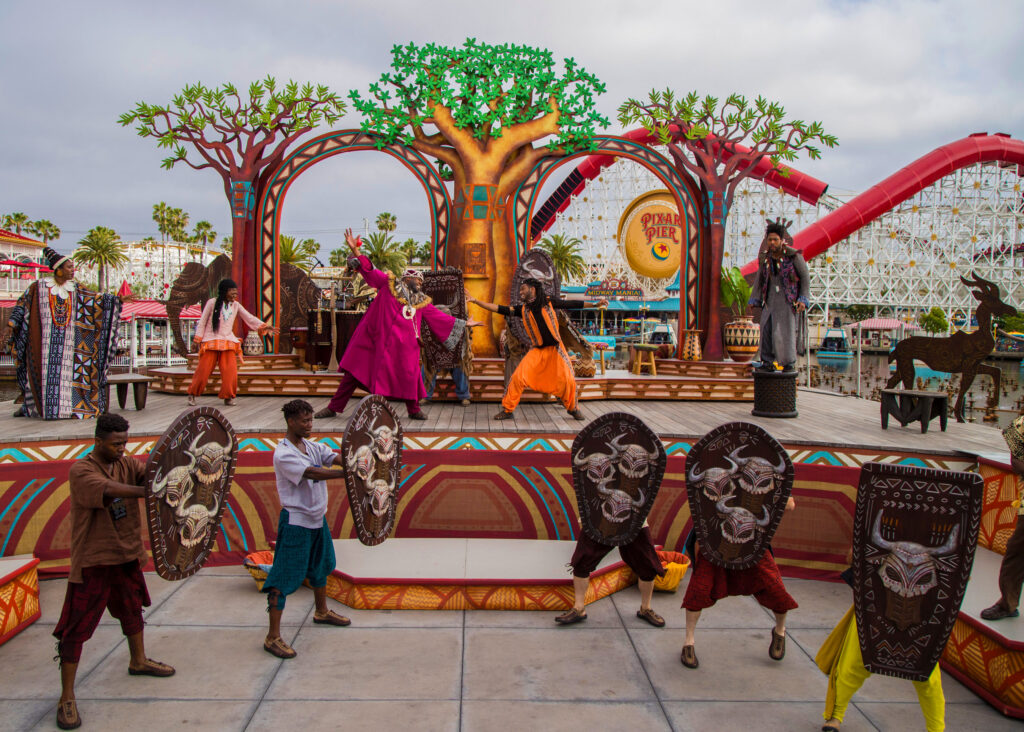
Tale of the Lion King at Disney California Adventure Park. Photo credit: Joshua Sudock/Disneyland Resort.
Did you discover anything through that workshop after all those months of preparation that surprised you or that changed anything that you hadn’t anticipated?
Yes, some questions came up about how to create more clarity around the Storytellers of the Pride Lands. There were moments when we felt the need to help guide the audience, especially because the show is performed in an outdoor venue in full daylight where there is no backstage, no wings, and no lighting to help focus the story on stage. So we wanted to make sure it was clear to our guests that, at this moment, this performer is not Nala; she is playing the part of an ensemble storyteller who is singing the vocal underscore during another character’s scene. To help with that, we made a change to Mwongozo’s opening monologue that introduces the premise of the show. In order to establish that all of the performers are members of the Storytellers of the Pride Land, it occurred to us to divide the lines from the monologue and assign them to each of the actors, in order to establish right away that they will all be sharing the act of storytelling at some point in the show. We also made some important discoveries about Mwongozo’s role and how she could help bring focus and also drive the story. As the lead narrator, she was able to weave in and out of the scenes of the play, casting around her an almost whimsical world of magical realism. She evolved into someone who could break time and space. For example, when Nala and Simba are reunited, Mwongozo crosses downstage between them as she tells the audience, ‘… and though they did not know it yet, it was written in the stars that these two were destined for one another.’ Over time, we saw how she could also help Mufasa’s scene of death, by holding his mane in her hands – a simple gesture that became symbolic of the death of the father.
These are the types of opportunities that the writers, director, choreographer, and composer worked through as they embraced the story-theater convention of a show where everything has to unfold ‘a vista.’ I’ve always been interested in the ways in which one can embrace the lie of theatre, to tell the truth of the story. That’s where the craft of theatre comes in and one can say ‘It’s okay. We can make this transition into a beautiful moment as we watch an actor add a costume accessory and turn into a character.’ The team uncovered a stylized and seamless approach to the staging of the storytellers, almost like a ballet. And the vernacular of the choreography for the young dancers required equal attention and we evolved a special perspective that was inspired by the culture of the story. I happened to find on Instagram a style of choreography that’s trending amongst kids and young people called ‘Afrobeat.’ I started to share with the creative team different videos of kids in Africa who were spontaneously getting up on top of their school desks and breaking into this joyous and youthful form of self-expression. It’s a great fusion of Hip Hop and African dance so we decided to lean into it. Most importantly we all agreed that we should not try to pretend like the Storytellers of the Pride Lands just got off the plane from Africa and arrived here. We said, let’s treat them as the keepers of a story that has been passed down from generation to generation to generation. And so, we created a mythology around the Lion King that doesn’t harken back to the films necessarily but does harken back to the beautiful, universal, deep story of a father and a son and the betrayal by the brother. You know, there are some really interesting archetypes in the original film, almost bordering on Greek Tragedy or Shakespearian theatre, and the writers successfully drew on all of that to focus our show and figure out how to trim the original story. That’s also part of what the workshop taught us: where we could tighten the storytelling in order to heighten the conflict of the play.
As far as research goes and people you conferred with, do you have a group of researchers on board? Do you reach out to professors?
Everything. All of the above. We have a Dramaturg – a creative assistant that works with us and does a lot of the research. Then again, I do research, the Show Director and the Art Director do research. We all do. We also meet with cultural consultants. We talk to our PULSE group, which is our Resource Diversity group here at the Disneyland Resort. We talk to The Walt Disney Studio, we pitch continuously, and we show our work in progress to different stakeholders to make sure we’re getting it right.
The Lion King‘s connection to us is strong. The story comes out soon in a new film and a whole new generation will get swept up in it. Do you think we will ever really understand why this story is so important to us?
The arrangements of those songs in this show are really lovely.
Absolutely. I am very enamored with the arrangements done by our Music Producer. It was important for the creative intent of the show that we do not use needle drops that would transport the audience into the cinematic world of the film. I wanted everyone to confront Simba’s emotional story in the here and now. And because we agreed that we were going to create this kind of mythological storytelling troupe that travels and brings the story here, it was imperative that the music has an authentic flavor that could be interpreted as ‘back then’ or ‘now’. To that end, we also incorporated three live drummers. One of my favorite arrangements is “Can You Feel the Love Tonight?” because it’s just so beautiful with that vocal chanting over it. And the mash-up of the duet of “I Just Can’t Wait To Be King” and “Be Prepared” — sung between Simba and Scar — that is something that, at first, my team was like, ‘What? You want to do what?’ But because we need to love to hate this Scar guy, I am thrilled that we found a way to give voice to the antagonist of the play. Thankfully we have brilliant performers playing those two roles and singing this amazing new musical duet that’s never been heard before. I think the success of the film has a lot to do with the point of view of the story, the father/son relationship is very powerful, and the songs are outstanding core material. The current success of Tale of the Lion King and Frozen – Live at the Hyperion at Disney California Adventure Park, and other equally wonderful stage shows being performed at Disneyland Park, demonstrates that there is as much interest in great theatre as there is in a great attraction.
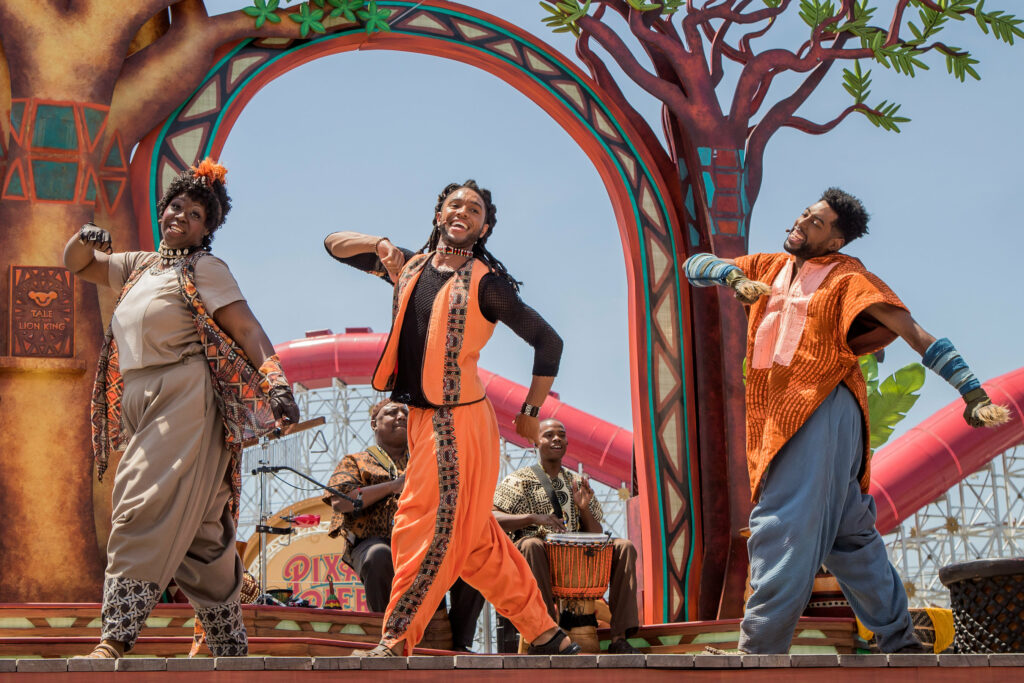
Tale of the Lion King at Disney California Adventure Park. Photo credit: Joshua Sudock/Disneyland Resort.
Tale of the Lion King runs for a limited time at Disney California Adventure Park. Susana Tubert is the Creative Director. Paul Bryant is the Show Director. John Glaudini is the Music Producer. The Show Writers are Chris Utley and Jason Milligan. Connie Mendieta is the Choreographer. Costumes Designed by Ida Muldrow with Art Direction by Scott Auerbach. Special thanks to Susana Tubert for taking the time to speak with us.
Here is a link to the Disney Parks Blog that includes a behind the scenes video of this production: https://disneyparks.disney.go.com/blog/2019/05/behind-the-scenes-of-tale-of-the-lion-king-coming-june-7-to-disney-california-adventure-park/
This post was written by the author in their personal capacity.The opinions expressed in this article are the author’s own and do not reflect the view of The Theatre Times, their staff or collaborators.
This post was written by Christine Deitner.
The views expressed here belong to the author and do not necessarily reflect our views and opinions.

